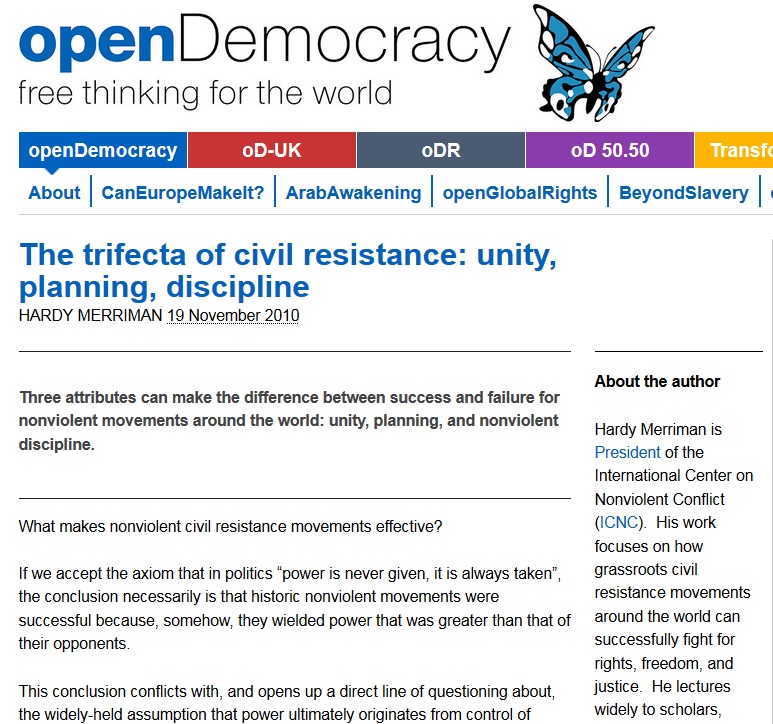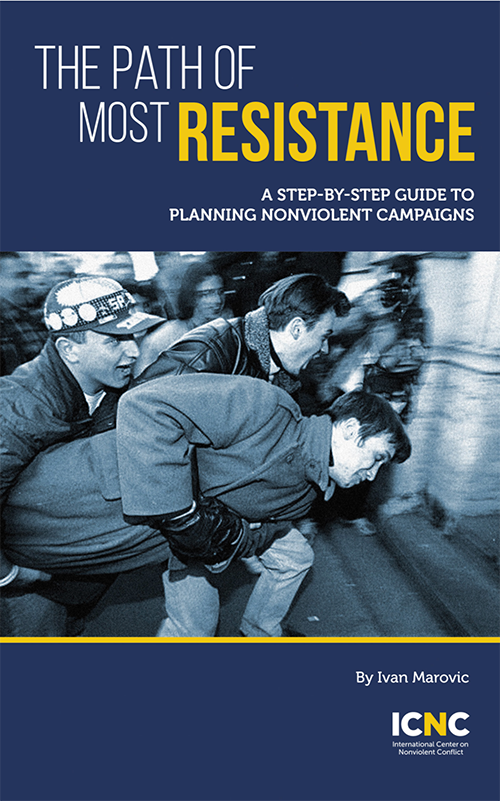Ten Key Resources for Activists and Organizers
The following ten resources provide a useful foundation of knowledge about civil resistance that can be applied in many contexts. Most are short, translated into multiple languages, and all are available for free online.
Please also visit our Resource Library to find hundreds of other resources on civil resistance in English and in over 70 different languages and dialects .
Fundamentals of Civil Resistance
1. "The Trifecta of Civil Resistance: Unity, Planning, Discipline"
by Hardy Merriman, openDemocracy.net (online), November 19, 2010
5 pages
Article arguing that unity, planning, and nonviolent discipline stand as three critical attributes that determine success or failure for a nonviolent movement.
Translations
Amharic | Arabic | Bahasa Indonesia | Bangla | Chinese | Crimean Tatar | Farsi | French | Georgian | Hebrew | Hindi | Hungarian | Kannada | Khmer | Kirundi | Kyrgyz | Malayalam | Nepali | Portuguese (Brazilian) | Portuguese (Continental) | Russian | Slovak | Spanish | Swahili | Tagalog | Tamil | Telugu | Thai | Turkish | Urdu | Vietnamese | Xhosa

2. "How the World is Proving Martin Luther King Right about Nonviolence"
by Erica Chenoweth and Maria J. Stephan, Washington Post, January 18, 2016
6 pages
Since 2011, the world has been a deeply contentious place. Although armed insurgencies rage across the Middle East, the Sahel and Southern Asia, violent civil conflicts are no longer the primary way that people seek to redress their grievances. Instead, from Tunis to Tahrir Square, from Zuccotti Park to Ferguson, from Burkina Faso to Hong Kong, movements worldwide have drawn on the lessons of Gandhi, King and everyday activists at home and abroad to push for change…
Translations
Amharic | Arabic | Bahasa Indonesia | Bangla | Chinese | Crimean Tatar | French | Hebrew | Hindi | Hungarian | Kannada | Khmer | Malayalam | Nepali | Polish | Portuguese (Brazilian) | Portuguese (Continental) | Russian | Spanish | Tamil | Telugu | Thai | Urdu | Vietnamese

3. "Civil Resistance: A First Look"
International Center on Nonviolent Conflict, 2010
16 pages
Civil resistance is a way for ordinary people to fight for their rights, freedom and justice without using violence. People engaged in civil resistance use diverse tactics, such as strikes, boycotts, mass demonstrations and other actions, to cause wide-ranging social, political and economic change. Around the world, civil resistance has been called by different names—nonviolent struggle, direct action, people power, political defiance, and civic mobilization—but regardless of which term is used, the fundamental dynamics of civil resistance remain essentially the same.
Translations
Amharic | Bahasa Indonesia | Bangla | Chinese | French | Hindi | Hungarian | Kannada | Kirundi | Kituba | Lingala | Malayalam | Nepali | Pashto | Portuguese (Brazilian) | Portuguese (Continental) | Russian | Slovak | Spanish | Swahili | Tagalog | Tamil | Telugu | Thai | Urdu

4. "Agents of Change and Nonviolent Action"
by Hardy Merriman, Conservation Biology, Volume 22, No. 2, April 2008
4 page
Nonviolent action is a way for ordinary people to fight for their rights, freedom, and justice. It is frequently associated with moral or ethical nonviolence, but in this article Hardy Merriman will define it as a distinct phenomenon, separate from any moral or ethical underpinnings, to expand on how it works as a pragmatic way to exert leverage in a conflict.
Translations
Amharic | Bahasa Indonesia | Bangla | Chinese | French | Georgian | Hindi | Hungarian | Kannada | Malayalam | Nepali | Portuguese (Brazilian) | Portuguese (Continental) | Russian | Sindhi | Spanish | Tagalog | Tamil | Telugu | Thai | Turkish | Urdu

Strategy and Tactics
5. The Path of Most Resistance: A Step-by-Step Guide to Planning Nonviolent Campaigns
by Ivan Marovic
120 pages
The Path of Most Resistance: A Step-by-Step Guide to Planning Nonviolent Campaigns is a practical guide for activists and organizers of all levels, who wish to grow their nonviolent resistance activities into a more strategic, fixed-term campaign. It guides readers through the campaign planning process, breaking it down into several steps and providing tools and exercises for each step. Upon finishing the book, readers will have what they need to guide their peers through the process of planning a campaign. This process, as laid out in the guide, is estimated to take about 12 hours from start to finish.
The guide is divided into two parts. The first lays out and contextualizes campaign planning tools and their objectives. It also explains the logic behind these tools, and how they can be modified to better suit a particular group’s context. The second part provides easily reproducible and shareable lesson plans for using each of those tools, and explores how to embed the tools in the wider planning process.
Translation:
Catalan | French | Hungarian | Polish | Portuguese (Brazilian) | Spanish | Vietnamese

6. CANVAS Core Curriculum: A Guide to Effective Nonviolent Struggle
by Srdja Popovic, Slobodan Djinovic, Andrej Milivojevic, Hardy Merriman, and Ivan Marovic, Belgrade, Serbia: Centre for Applied Nonviolent Action and Strategies (CANVAS), 2007
285 pages
The content of the curriculum is divided into three parts:
I. Theory and its applications
II. Planning considerations
III. Organizational and operational considerations
Translations
Arabic | Chinese | Farsi | Slovak

7. Handbook for Nonviolent Campaigns
by Howard Clark, Javier Gárate, Joanne Sheehan, and Dorie Wilsnack, War Resisters’ International, 2014
232 pages
Social change doesn’t just happen. It’s the result of the work of committed people striving for a world of justice and peace. The work gestates in groups or cells of activists, in discussions, in training sessions, in reflecting on previous experiences, in planning, in experimenting and in learning from others. Preparing ourselves for our work for social justice is key to its success.
Translations
Arabic | Catalan | Indonesian | Korean | Russian | Sindhi | Slovak | Spanish | Tigrigna | Turkish | Ukrainian

8. "The Checklist for Ending Tyranny"
by Peter Ackerman and Hardy Merriman, in Mathew Burrows and Maria J. Stephan (eds.), Is Authoritarianism Staging a Comeback?, Washington, DC: The Atlantic Council, 2015
15 pages
Today the most deadly conflicts in the world are not between states but rather within them, pitting tyrants against the populations they oppress. It is widely believed that these oppressed populations have two choices: acquiesce to tyranny in hopes that it will evolve to something milder or launch a violent insurrection to gain freedom. This limited view is refuted by the fact that civil resistance campaigns (sometimes referred to as “people power” movements or nonviolent conflicts) have occurred far more frequently than generally realized. Beginning in 1900, there has been on average one major campaign of civil resistance challenging an incumbent ruler per year. These citizen-‐led movements have increasingly defined the outcome of the most geo-politically significant conflicts and democratic transitions since 1972. Yet policy makers, scholars, journalists, and other interested observers consistently underestimate this capacity of ordinary people to undermine tyranny and achieve rights without violence.
Translations
Amharic | Arabic | Bangla | Bahasa Indonesia | Chinese | Farsi | French | Georgian | Haitian Creole | Hebrew | Hindi | Hungarian | Kannada | Malayalam | Nepali | Polish | Portuguese (Brazilian) | Portuguese (Continental) | Russian | Sindhi | Spanish | Swahili | Tagalog | Tamil | Telugu | Thai | Turkish | Urdu | Vietnamese

9. "The Need for New Tactics"
by Douglas A. Johnson, The New Tactics in Human Rights Project, 2004
8 pages
Johnson calls on the global community of human rights activists to develop and implement new approaches to combat the persistence of torture in the 21st century. Thesis is that “Tactical thinking is essential to an effective struggle for human rights.”
Translations
Arabic | Croatian | Farsi | French | Kiswahili | Mongolian | Polish | Russian | Spanish | Ukrainian | Uzbek

10. "Backfire Basics"
by Brian Martin, Irene Publishing, 2012
4 pages
Short document detailing the tactical basics that nonviolent organizers can employ to produce backfire.
Translations
Amharic | Arabic | Bahasa Indonesia | Bangla | Chinese | French | Georgian | German | Hindi | Hungarian | Italian | Kannada | Malayalam | Nepali | Portuguese (Brazilian) | Portuguese (Continental) | Russian | Spanish | Tagalog | Tamil | Telugu | Thai | Turkish | Urdu
